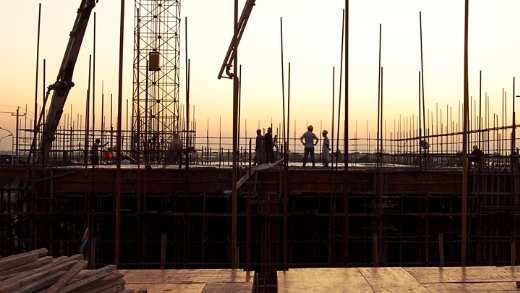The US and China continue to trade blows as each side looks to limit the other’s access to vital products. With industrial policies also making a comeback, companies are having to navigate a rapidly changing business environment. We look at the key implications for investors.
Read this article to understand:
- Why economic nationalism points to higher inflation
- The implications for different sectors of rising economic hostilities between China and the West
- Why this could hinder global efforts to decarbonise
On July 3, two previously obscure metals, gallium and germanium, were thrust into the spotlight as China’s Ministry of Commerce announced plans to restrict exports.1 China is by far the world’s biggest producer of both metals. According to an EU study, it accounts for 94 per cent of global output of gallium and 80 per cent of germanium.2
Gallium is used in the semiconductor industry and has applications in 5G telecoms, electric vehicles (EVs) and military equipment. Germanium has uses in the production of fibre optics, infrared optics and satellite solar cells. The metal and its oxides are used in military applications like night-vision devices as well as satellite-imagery sensors.
The restrictions, which went into effect on August 1, were the latest salvo in an escalating economic war between China and the United States. Washington’s introduction of a series of measures designed to limit Beijing's access to advanced microprocessor technology has been central to that fight.
While both Western companies and those in China will eventually find ways around the restrictions, this will take time, disrupt supply chains and come at a cost.
“Globalisation may not have been without some serious flaws, but for two decades the outsourcing of manufacturing to China has been deflationary. Its reversal threatens persistently higher inflation,” says Michael Grady, head of investment strategy and chief economist at Aviva Investors.
Figure 1: US manufacturing employment, 1998-2023 (million workers)
Source: Federal Reserve Bank of St. Louis, July 2023.
The re-shoring of jobs from China has helped push US manufacturing employment to its highest level in 15 years, as shown in Figure 1. With 1.4 million jobs lost at the start of the pandemic quickly recovered, it now stands at just under 13 million.
With labour markets in the US and much of Europe already extremely tight, efforts by Western companies to re-shore manufacturing jobs are putting upward pressure on wages as companies scramble to hire skilled workers.
US manufacturers increasingly find themselves struggling to fill positions with 693,000 vacancies in the sector as of March 2023. According to the US Chamber of Commerce, even if every unemployed person with experience in the durable goods industry were employed, only three-quarters of vacant jobs would be filled.3
Computer chips
Shortages are especially acute within the semiconductor industry as Washington tries to cut its reliance on imports of advanced computer chips. It is spending $280 billion to encourage R&D, raise semiconductor capacity, create regional high-tech hubs and tackle skill shortages.4
Richard Saldanha, global equities portfolio manager at Aviva Investors, says the legislation, passed in August 2022, along with the European Chips Act, was in part a response to the events of 2020. The dangers of being dependent on chip manufacturing, based almost entirely in Asia, became increasingly apparent to US and European companies due to the COVID-19 pandemic.
“There’s a desire to have control of your semiconductor supply chain, rather than needing to ship it from the other side of the world. The risks are being exacerbated by security concerns as tensions with China continue to escalate,” he says.
Building up domestic production capacity will not be straightforward. Taiwan Semiconductor Manufacturing Company (TSMC), the largest chip maker in the world, recently delayed plans to start manufacturing at a new plant in Phoenix, Arizona.
It has blamed a lack of skilled labour and is trying to fast-track visas for 500 Taiwanese workers. Unions, meanwhile, are accusing the company of inventing the skills shortage as an excuse to hire cheaper, foreign labour.5
Attempts to replicate TSMC’s fabs in the US are causing issues
“TSMC’s fabs [fabrication plants] in Taiwan have a highly trained, obedient workforce, making them incredibly efficient. Attempts to replicate this in the US are causing issues,” says Alistair Way, head of equities at Aviva Investors.
He believes a sizeable chunk of the world’s production of semiconductors will nonetheless eventually relocate to the US as the likes of Apple and Nvidia want their chips made at home, even if that pushes up the cost by as much as 50 per cent. After all, Nvidia currently pays TSMC just $1,000 to produce a top-end-of-the-range chip, which it can in turn sell for $40,000.
Made in America
“I think customers would be prepared to pay that much extra to get security of supply and have a made-in-America certification. The result will be a less efficient industry as there will be more plants than are needed,” says Way.
With China simultaneously ramping up its own chip-making capacity as it looks to sidestep US sanctions, the current environment is providing a bonanza for firms that make the machines used to manufacture semiconductors. They include ASML, the world leader, Dutch peer ASM International, US rivals Lam Research and Applied Materials, and Tokyo Electron of Japan.
The intensity of US measures towards China has been progressively ratcheted up over the past five years
The intensity of US measures towards China has been progressively ratcheted up over the past five years and is focused increasingly on advanced chips that can be used for AI and military applications. Chinese companies have begun purchasing large quantities of chips and chip-making equipment, fearful restrictions will be tightened further.
The Financial Times reported at the start of August that four Chinese tech giants – Baidu, ByteDance, Tencent and Alibaba – had ordered $5 billion worth of high-performance Nvidia chips amid the threat of new US export controls.6 Way suspects Chinese chip-making companies have been placing a lot of orders for ASML machines for similar reasons.
In retaliation, China is weaponising the supply of critical minerals for geopolitical gain. The country dominates, and in some cases boasts a virtual monopoly, when it comes to processing numerous metals, as shown in Figure 2 and Figure 3. Since they have applications in a host of technologies, Beijing’s actions risk further disruption to global supply chains.
Figure 2: Where clean energy minerals are produced
Source: International Energy Agency, May 2021.7
Figure 3: And where they are processed
Source: International Energy Agency, May 2021.8
China puts the West on notice
“The restrictions on gallium and germanium exports puts the US and its allies on notice of China’s willingness to dial up the pressure on other critical material exports and inflict more significant economic harm,” says Xiaomeng Lu of political consultancy Eurasia Group.
Western governments have for some time spoken about the need to “de-risk” from China, by being less reliant on it for both raw materials and finished products. However, diversifying supply chains and building up the capability to mine and then, crucially, process metals and minerals will not be straightforward.
Katherine Tai conceded that China’s dominance in rare earths makes US supply chains vulnerable
While Lu says firms should be able to find substitutes for materials such as gallium and germanium, US Trade Representative Katherine Tai conceded on August 26 that China’s dominance in rare earths makes US supply chains vulnerable.9
By complicating the efforts of the US, EU and others to be at the forefront of developing green technologies, China’s actions could stymie efforts to combat climate change. Luke Mulley, utilities and energy analyst at Aviva Investors, says the threat posed by China partly explains the rationale for US President Joe Biden’s Inflation Reduction Act (IRA).
With a commitment to pump more than $1 trillion worth of subsidies and tax breaks, it promises to shake up US energy and foreign policy in dramatic ways. It commits to increasing the domestic supply of critical minerals such as lithium, nickel, manganese and graphite to provide the materials necessary for a vast expansion in EVs, batteries and renewable power production infrastructure. However, the process is likely to take years.
Nationalist route
Mulley says the US has gone down a nationalist route to try and get domestic production of batteries and solar panels in particular, and also wind turbines, up and running. However, he is sceptical China’s dominance will be eroded.
“In many areas of the renewable supply chain, the battle is already won. There is no doubt China will supply the majority of solar panels and batteries for the next ten, even 20, years given its scale,” says Mulley.
When it comes to manufacturing solar panels, for example, the process essentially involves five stages. In the case of four of them, between 80 and 97 per cent of global capacity is in China.
The fact China is expanding output very fast means other countries will find it exceptionally difficult to catch up
“The fact China is expanding output very fast means other countries will find it exceptionally difficult to catch up. Even in the IRA, the US is focused on just two of the five processes, which is an implicit acceptance it will be too difficult to catch up in the others,” Mulley says.
China’s dominance puts the West in a bind. Europe, for instance, has been more open to free trade with China. But having until recently held a dominant position in wind turbine manufacturing, it too is starting to adopt a more protectionist stance.
Chinese company Goldwind last year became the world’s largest wind turbine manufacturer. Mulley says Goldwind and other Chinese firms not only have a labour cost advantage, but are being subsidised by the state, partly via reduced energy bills.
Europe on the defensive
European firms, having until recently boasted there was little danger of being undercut by Chinese rivals given their technological advantage, are suddenly on the defensive.
Trade body WindEurope, and the chief executives of the top five European turbine manufacturers, last year wrote to the president of the European Commission, Ursula von der Leyen, urging her to support the industry’s supply chain or risk failure to meet the bloc’s Green Deal ambition.10
Many EU leaders are concerned the IRA will encourage companies to relocate
The Commission in February proposed allowing increased levels of state aid so that Europe can compete with the US as a manufacturing hub for EVs and other green products.11 Many EU leaders are concerned the IRA will encourage companies to relocate, making the US a leader in green technologies at Europe's expense. They simultaneously want to reduce the dependence on China.
"We see that major economies are stepping up their investment in the net-zero industry – rightly so… We are competitive, we need competition. What we are looking at is that we have a level playing field in the global competition," von der Leyen said.12
Car wars
As protectionism grows, more and more companies are finding themselves in the firing line. Apple shares plunged 6.4 per cent in the space of two days in early September, wiping $190 billion from the US tech group’s market value, after Beijing ordered some central government employees to stop using iPhones at work.13
The car industry is another sector starting to feel the effects of the rising tide of economic nationalism. China has in recent years built up a dominant position in the manufacture of batteries for EVs.
Ed Kevis, equity portfolio manager at Aviva Investors, says fears they could be cut off from battery supplies in the future has prompted Western automakers to source batteries from outside Asia.
In September 2021, German automaker Mercedes-Benz took a stake in European battery cell manufacturer Automotive Cells Company (ACC). German rival Volkswagen has gone further, setting up its own business, PowerCo, which it claims will offer vertical integration from sourcing raw materials to manufacturing cells, through to recycling.
With batteries accounting for a substantial percentage of the cost of a new EV, Kevis sees a danger China’s automakers will look to use the country’s strength in battery production to their advantage.
Chinese companies may start to outcompete foreign rivals at home and abroad
“Chinese companies are rapidly expanding their production of EVs. As they capture an ever-bigger share of the overall car market, they may start to outcompete foreign rivals at home and abroad,” he says.
BMW chief executive Oliver Zipse recently warned European automakers were being pushed into a price war with Chinese rivals that is “fundamentally impossible” to win. He said the basic car segment will face two possible outcomes: either it will disappear, or it will no longer be dominated by European automakers.14
He noted Chinese automakers, such as BYD, are aggressively expanding into the EV market and are becoming increasingly ambitious. Zipse pointed to Volkswagen, which has been dethroned as China’s best-selling automaker by BYD.
As geopolitical tensions rise, is seems safe to assume economic nationalism is here to stay. That in turn presents investors with a growing list of risks and opportunities as more and more companies are caught in the firing line.
“The likelihood is the US and China will continue to decouple their economies. As we saw recently with Apple, this has potentially huge ramifications for companies across a host of industries, which investors need to be alert to,” Saldanha says.


















